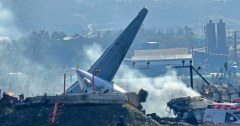Taipei, Taiwan – The fatal crash of Jeju Air Flight 2216 in South Korea has focused attention on the risks birds can pose to commercial airliners.
Pilots told air traffic control that their aircraft collided with a flock of birds shortly before declaring Mayday and making an emergency landing at Muan International Airport, according to South Korea’s Ministry of Land, Infrastructure and Transport.
Footage of the crash on Sunday showed the twin-engine Boeing 787-800 making a belly-flop landing on the runway without its landing gear deployed.
The aircraft then skidded across the tarmac before hitting a concrete wall and exploding into flames, killing 179 of 181 people on board.
While large birds in particular can pose dangers to aircraft, it would be highly unusual for a bird strike alone to cause a crash, aviation experts said.
Dane Williams, director of the consultancy Aviation Safety Asia, said it would be “extremely unlikely” for a bird to bring down a modern aircraft such as a Boeing 787-800.
“The engines are designed to actually to expel any foreign objects,” Williams told Al Jazeera.
Geoffrey Thomas, the Australia-based editor-in-chief of Airline Ratings, said a bird strike would most likely only be partially to blame.
Evidence points to the aircraft experiencing an electrical failure because it stopped transmitting location data – known as “ADS-B data” – to air traffic control shortly after declaring Mayday, Thomas said.

“It appears as though these pilots were dealing with cascading failures, the exact nature of which we don’t know. What we do know is the ADS-B data stopped, they didn’t deploy their flaps for landing, and they didn’t deploy the undercarriage,” Thomas told Al Jazeera.
“Now, why those things happen, we don’t know, but it all happened after air traffic control warned of a flock of birds,” Thomas added.
It will likely be months before investigators determine the cause of the crash, which is the deadliest air disaster to ever take place on South Korean soil.
South Korean authorities are probing the crash alongside the United States’ National Transportation Safety Board in accordance with global aviation regulations because the Boeing aircraft involved was made in the US.
Bird strikes are a relatively common hazard for commercial aviation but rarely result in serious accidents.
The US Federal Aviation Administration (FAA) reported 19,400 wildlife strikes – including birds – at US airports in 2023 alone. US airlines reported another 236 strikes across 55 countries in the same year, according to FAA data.
In the vast majority of cases, the most serious outcome is minor damage to the aircraft, with such incidents costing the industry some $1.5bn a year, according to Thomas.
Thomas said bird strikes have become more common due to the growth of air travel, with more than 120,000 commercial flights each day around the world, and the development of quieter planes.
Most often, though, aircraf





